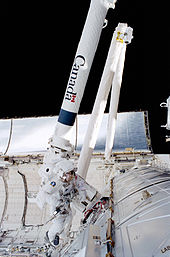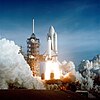STS-100
| Mission emblem | |||
|---|---|---|---|

|
|||
| Mission dates | |||
| Mission: | STS-100 | ||
| COSPAR-ID : | 2001-016A | ||
| Crew: | 7th | ||
| Begin: | April 19, 2001, 18:40:42 UTC | ||
| Starting place: | Kennedy Space Center , LC-39A | ||
| Space station: | ISS | ||
| Coupling: | April 21, 2001, 13:59:00 UTC | ||
| Decoupling: | April 29, 2001, 17:34:00 UTC | ||
| Duration on the ISS: | 8d 3h 35m 00s | ||
| Landing: | May 1, 2001, 16:10:42 UTC | ||
| Landing place: | Edwards Air Force Base , Runway 22 | ||
| Flight duration: | 11d 21h 30min 00s | ||
| Earth orbits: | 186 | ||
| Track height: | approx. 320 km | ||
| Covered track: | 7.9 million km | ||
| Payload: | Canadarm2 , MPLM Raffaello | ||
| Team photo | |||
 v. l. No. seated in front: Kent Rominger, Jeffrey Ashby; standing in the back: Yuri Lontschakow, Scott Parazynski, Umberto Guidoni, Chris Hadfield, John Phillips |
|||
| ◄ Before / After ► | |||
|
|||
STS-100 ( english S pace T ransportation S ystem ) is the mission designation for a flight of the US Space Shuttle Endeavor (OV-105) of NASA . The launch took place on April 19, 2001. It was the 104th space shuttle mission, the 16th flight of the space shuttle Endeavor and the 9th flight of a shuttle to the International Space Station (ISS).
team
- Kent Rominger (5th space flight), commander
- Jeffrey Ashby (2nd space flight), pilot
-
Umberto Guidoni (2nd space flight), Mission Specialist ( ESA / Italy )


-
Chris Hadfield (2nd Space Flight), Mission Specialist ( CSA / Canada )


-
Yuri Lontschakow (1st space flight), mission specialist ( Roskosmos / Russia )


- Scott Parazynski (4th Spaceflight), Mission Specialist
- John Phillips (1st spaceflight), mission specialist
Mission overview
The highest priority on this flight was the delivery and installation of the Canadarm2 robotic arm , part of the Space Station Remote Manipulator System, which was of essential importance for the further expansion of the station. The last component should come with flight STS-104 .
A new set of experiments with Raffaello, the second of three Italian multi-purpose logistics modules, was also delivered. Moreover, in addition to various supply goods also was UHF - antenna brought to the station, which was for direct communication with outboard maneuvers needed. Two EVAs were carried out by the crew during their stay on the International Space Station (ISS).
Mission history
Other important equipment for the International Space Station was on board the Endeavor. The most important part was the Canadian manipulator arm (SSRMS). It was mounted on the outside of the Destiny laboratory module on April 22nd. For this purpose, a Spacelab pallet was lifted out of the shuttle's hold for the first time . The folded manipulator arm was housed on it.
The Canadarm2 manipulator system, built in Canada, was initially mounted on the US laboratory module. The manipulator was placed on a mobile base on a later mission. This can be moved on rails on the central lattice structure and thus enables work on all components from the USA, Europe and Japan.
Two scientific racks as well as supplies and additional equipment were transported in the multi-purpose module Raffaello. The EXPRESS-Rack 1 contained the vibration measurement complexes SAMS (Space Acceleration Measurement System) and MAMS (Microgravity Acceleration Measurement System), a system for the investigation of plant growth (ADVASC), two experiments for the production of different protein crystals (Protein Crystal Growth - Single Locker Thermal Enclosure System) , 1 ° C to 4 ° C) as well as two commercial payloads in which pharmaceuticals were produced by fermentation or protein crystals for medical research. The EXPRESS-Rack 2 housed the ARIS vibration damping unit, an experiment to control vibration damping (ARIS-ICE), a physical experiment with particle-liquid mixtures (colloids) and a SAMS control unit.
EXPRESS racks (EXpedite the PRocessing of Experiments to the Space Station) are standardized, transportable metal cabinets with connections for ventilation, coolant, energy, video as well as command and measurement data lines. Individual areas of a rack can be regulated independently of one another (time and temperature control) and accommodated experiments in the scientific fields of biology , chemistry , medicine , ecology and physics . The experiments usually run largely automatically and are controlled from the ground. The astronauts on board the station carry out maintenance work (e.g. changing data carriers), but can also take control manually.
After docking on April 21, final preparations were made for Parazynski and Hadfield's first spacecraft the following day. The two astronauts worked outside the space shuttle for 7 hours and 10 minutes. To do this, they first installed a UHF antenna on an approximately 1.3 m long boom on the outside of Destiny. This is part of a communication system for voice and data that is used by space travelers in orbit. Space travelers can communicate wirelessly with their colleagues in the station or in the shuttle during outboard work. Then they connected several power and data cables from the station's new manipulator, which was resting on a Spacelab pallet, with the appropriate connections on Destiny, unfolded the manipulator and locked the segments in place with several stable bolts.
On April 23rd, commands were given to the manipulator from the station to dock with one end at the attachment point on Destiny and to bring the other end into a certain position. The Raffaello logistics module could then be lifted out of the loading bay with the shuttle manipulator and connected to Unity . The regular crew of the space station began unloading immediately. The hatches between the station and the space shuttle were also briefly opened and further equipment was transported into the ISS.
Raffaello corresponded in size and shape to the Leonardo module that was used in March. On this flight, the cargo consisted primarily of scientific equipment and supplies that were housed in standard racks or on cargo platforms. The logistics module built in Italy was one of three such devices and had its own systems for ventilation, cooling and lighting. It was 6.4 meters long, cylindrical with a diameter of 4.6 meters. Its curb weight was around 4.1 t. It could hold up to around 9 t of payload in 16 racks. A maximum of 5 racks could be internally supplied with energy from the start to the docking of the space shuttle or after decoupling until landing. The transport module was anchored in the cargo bay of a space shuttle and brought into orbit. There was no possibility of access from the shuttle.
During the second exit on April 24th (7:40 am), the power and data connections at the attachment point on the Destiny module were completed and the auxiliary cables that had been installed during the first mission were dismantled. In addition, an antenna that is no longer required has been removed from the laboratory module. Finally, Parazynski and Hadfield installed an additional power converter that would be required for future assignments. The new Space Station Remote Manipulator System (SSRMS) could not be subjected to an initial test until April 28th. Susan Helms and later James Voss operated the control computer and let Canadarm2 swing the 1.4 t assembly pallet over to the shuttle's loading bay. There it was taken over by the shuttle's manipulator arm, operated by Canadian Chris Hadfield, and anchored in the loading bay. The training of movements that should be carried out when coupling the exit lock for the next shuttle mission had to be omitted for reasons of time.
On the night of April 25, the failure of the primary control computer caused a stir in the ground control. As a result, tests with the station's manipulator, as well as other work, were delayed. Restoring the computer system via a backup did not initially succeed. The command functions could also not be transferred to one of the two replacement computers provided for such cases. The failure primarily affected the communication between the ground station and the ISS. Conversations and data exchange could, however, be continued via the Endeavor systems. To solve the problem, the shuttle's flight was extended by one day. The following morning, Susan Helms managed to get the primary computer back into a normal working mode through a series of problem-solving steps. Computer specialists on earth then dealt with the analysis of the error. Apparently the hard drives of the primary control and command system as well as a backup computer were defective. Therefore the primary command computer was exchanged for a payload computer and its hard disk was provided with the necessary software. The other two computers were also being worked on. Synchronization and testing formed the preliminary completion of the repairs on April 29th. (The regular crew of the ISS was able to successfully complete the repairs in mid-May.)
On April 27, the Raffaello transport module was locked, disconnected from Unity and transported back to the loading bay with the shuttle's manipulator. One day later, the Spacelab pallet followed, on which the station's new manipulator had been transported. In the station, the already heavily worn running surface of the treadmill was also replaced.
As always, some routine experiments were carried out before, during and after the flight. These included u. a. Investigations on the reactivation of "sleeping" viruses in the human body through the special stress factors of space flight (including Epstein-Barr virus), studies on changes in the cardiovascular and immune systems, vibration tests (ISS On-Orbit Loads Validation, On-Orbit Bicycle Ergometer Loads Measurement) for engine ignition and exercises on the bicycle ergometer, path tracking and recording via GPS, examinations of the sense of balance and the test of a system of autonomous sensors that transmit their measurement data wirelessly and in real time to a laptop (micro-wireless instrumentation system) .
The Endeavor undocked from the International Space Station on April 30th to make way for the next visiting team. The landing took place because of bad weather not in Florida, but in Edwards (California).
See also
Web links
- NASA Mission overview (English)
- NASA website of the Mission (English)
- NASA video of Mission (English)
- Video summary with comments of the crew (English)


